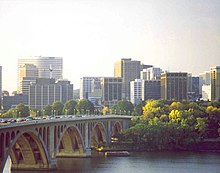Demolition of Aqueduct Bridge
Side view of second Aqueduct Bridge abutment, with Water Street and Whitehurst Freeway visible through the arch.
In January 1917, the Corps of Engineers found that inflation in the price of construction materials made it necessary to ask for $300,000 more in funding from Congress.[63] Congress balked at paying.[64] But citizen pressure and the danger of collapse due to ice flows in the spring[65] convinced Congress to pay the money. Construction contracts were drawn up in late February,[66] and excavation work on the D.C. abutments began in March.[67] The first coffer dam for construction of the piers was sunk in May 1918,[68] and, in July 1921, the Aqueduct Bridge was ordered to be closed.[69] The new $2.35 million Key Bridge opened on January 17, 1923, whereupon the Aqueduct Bridge was closed to traffic.[70]
Although Georgetown citizens pressed for the old Aqueduct Bridge span to remain open for use as a recreation site,[71] the bridge was razed beginning in December 1933.[72] The Aqueduct Bridge's superstructure and most of the above-water portions of its piers were removed in 1933.[73] The bases of the piers were retained to protect the Key Bridge's piers from ice floe damage.
The piers, however, were criticized by recreational boaters (particularly rowers from nearby Georgetown University) as an obstacle to enjoyment of the river and a navigational hazard.[73][74][75] Army engineers and Rep. Joel Broyhill refused to remove the piers, citing their value to protecting Key Bridge and the cost of their removal. But in August 1962, these groups agreed that seven of the eight Aqueduct Bridge piers would be removed (with one pier remaining as a historical marker).[74][75][76] Dismantling of the piers began on September 11, 1962.[77] The pilings were blasted out to a depth of 12 feet (3.7 m) below the waterline.[78]
The Aqueduct Bridge's Washington abutment and a remnant of the bridge's Virginia abutment still survive. Both are located a short distance west (upstream) of the Key Bridge.[74] The southern arch of the Washington abutment shelters rowing shells belonging to members of the Potomac Boat Club.[79] Between the abutments, the preserved pier remains in place near the river's Virginia shoreline.[74]
A coalition of Georgetown business groups and residents have joined with Georgetown University to advocate the construction of a gondola that would cross the river along the former path of the Aqueduct Bridge. Conceptual images show that a pole supporting the gondola's cables would rise from the bridge's remaining pier.[80]
Images
First bridge
First bridge after superstructure built
Second bridge
Remnants
- Aerial view of Key Bridge and George Washington Memorial Parkway, with pier of Aqueduct Bridge visible in the foreground and remnant of Aqueduct Bridge abutment visible on the Virginia shoreline (c. 1990)
- Pier and remnant of Virginia abutment of the Aqueduct Bridge upstream of Key Bridge (2005)














No comments:
Post a Comment